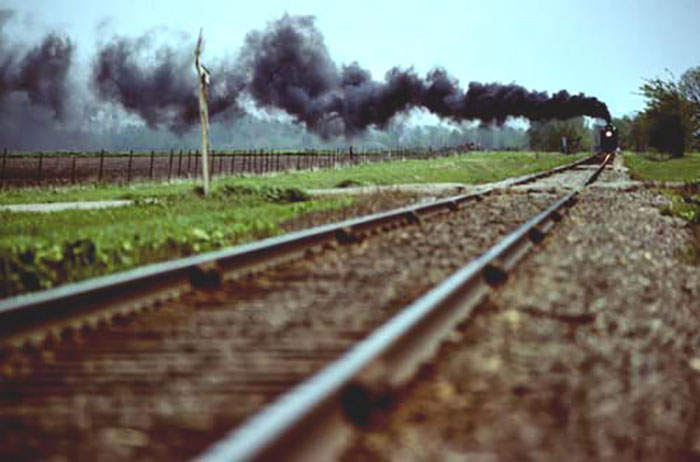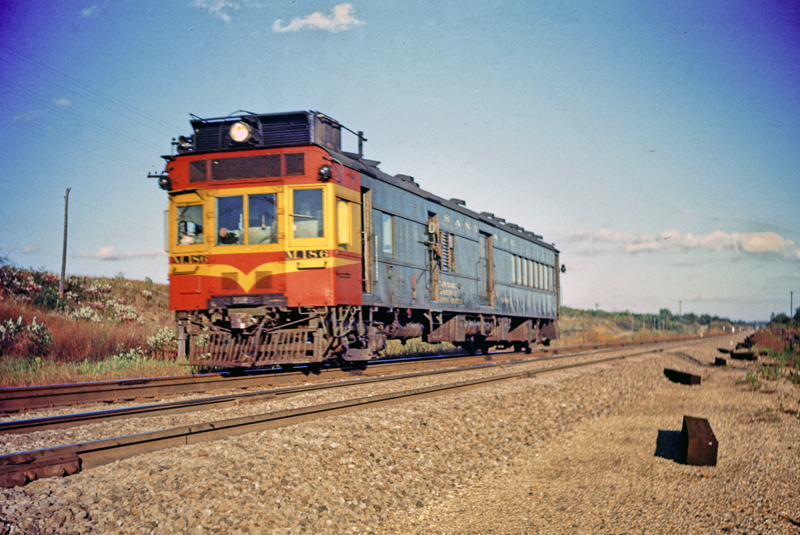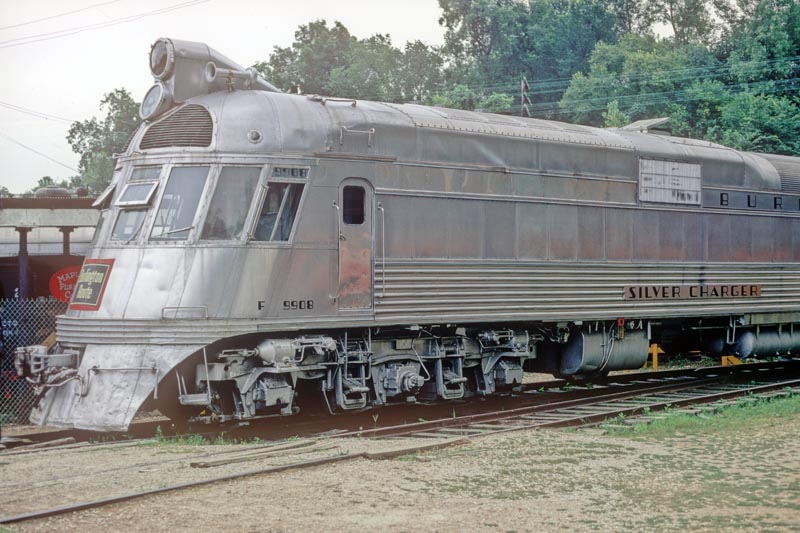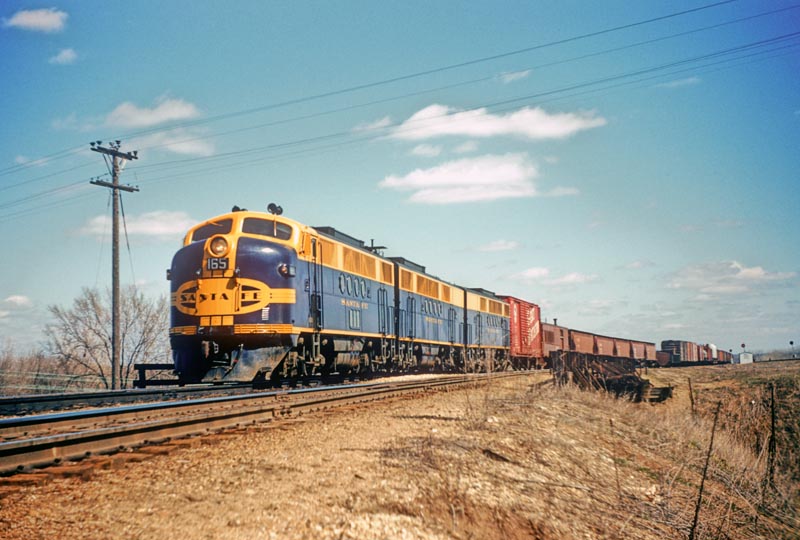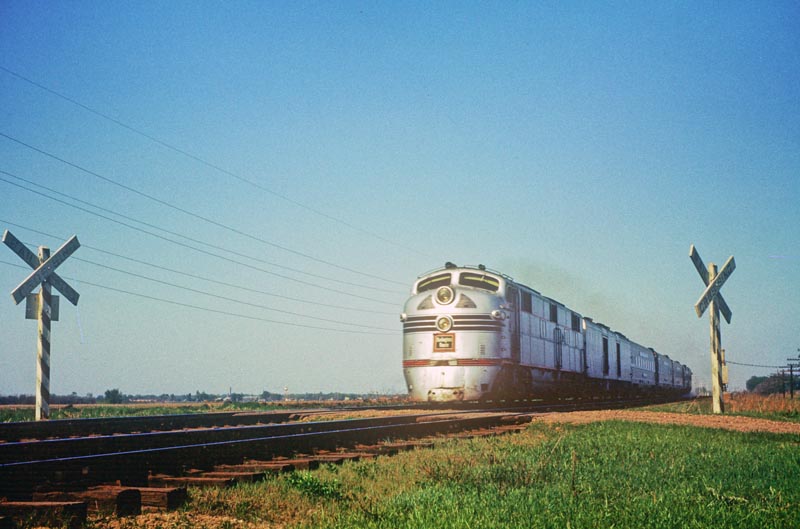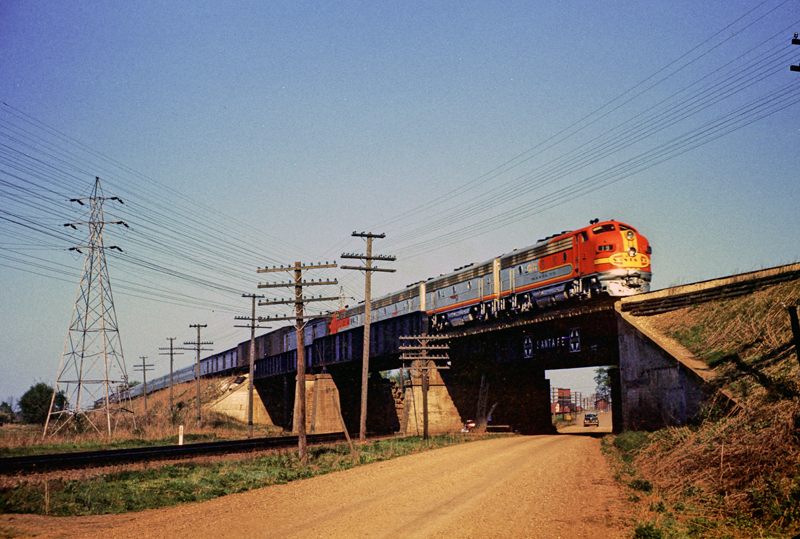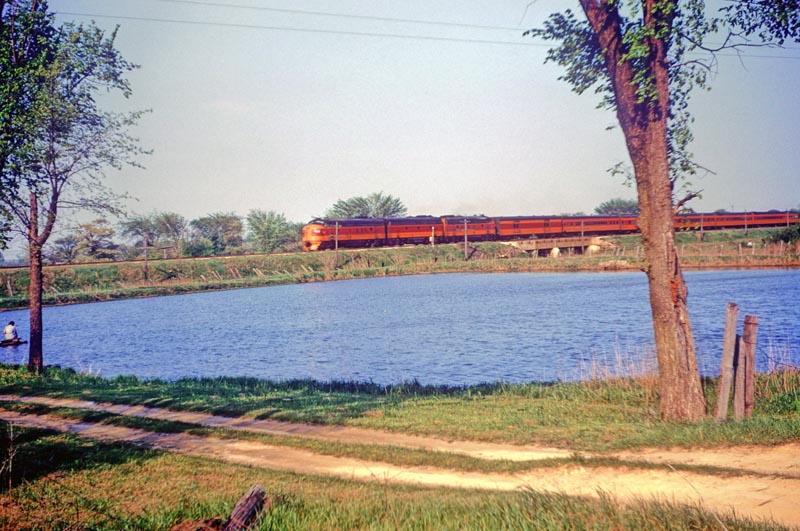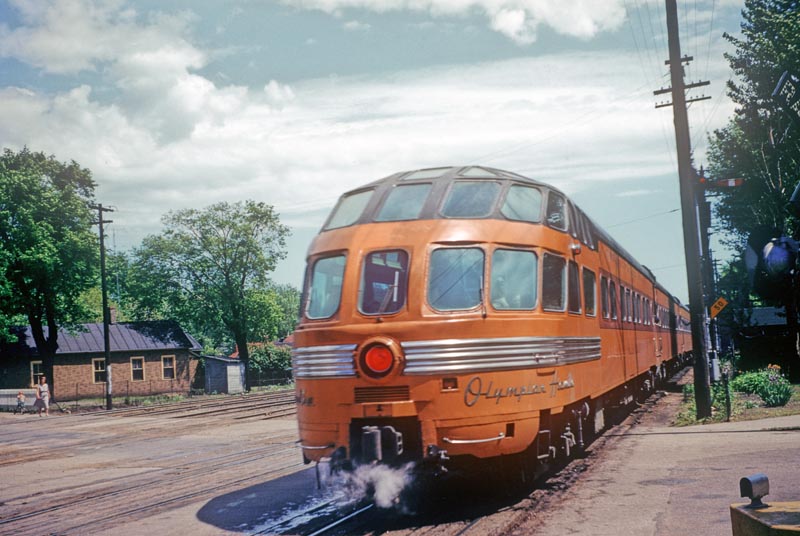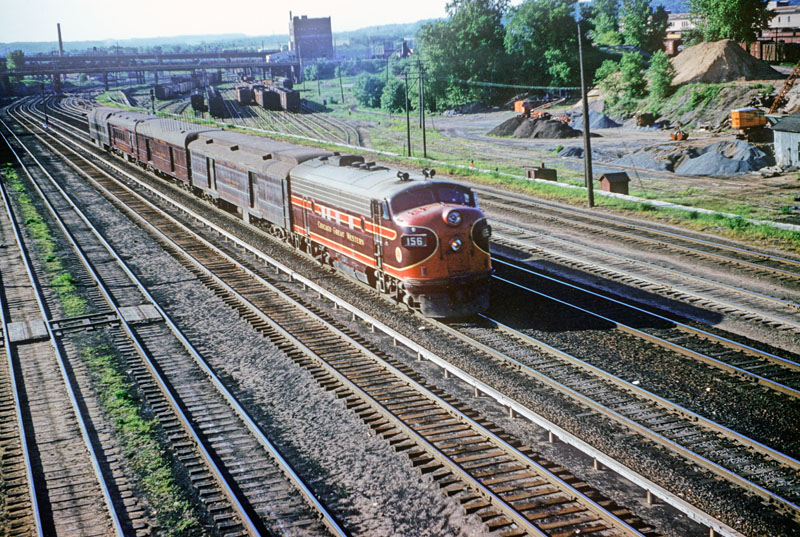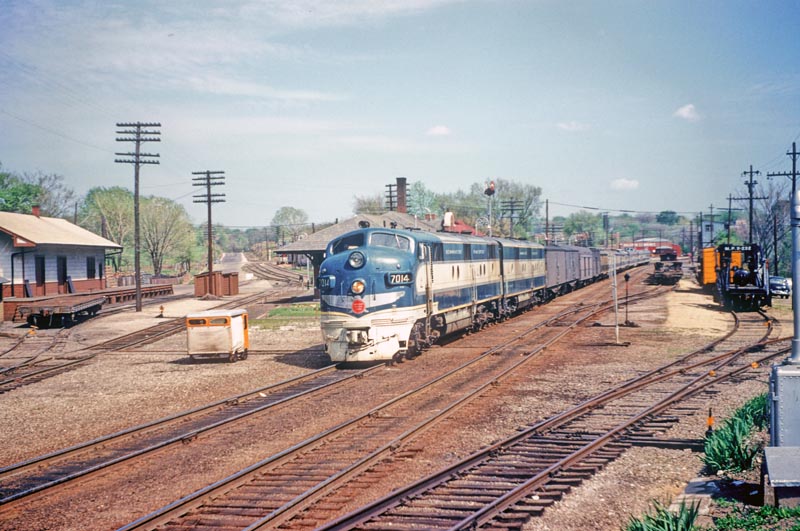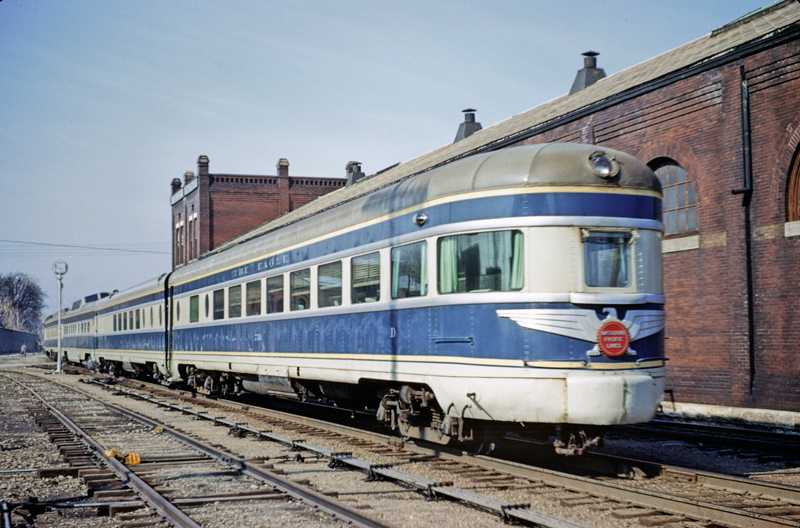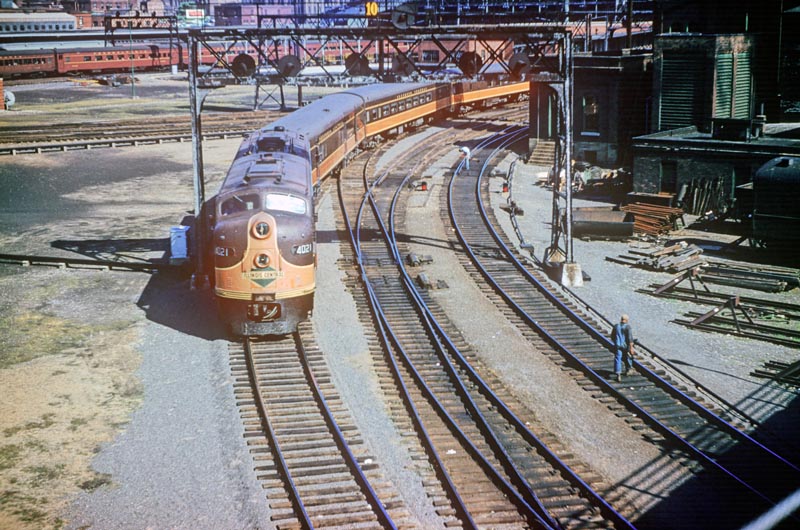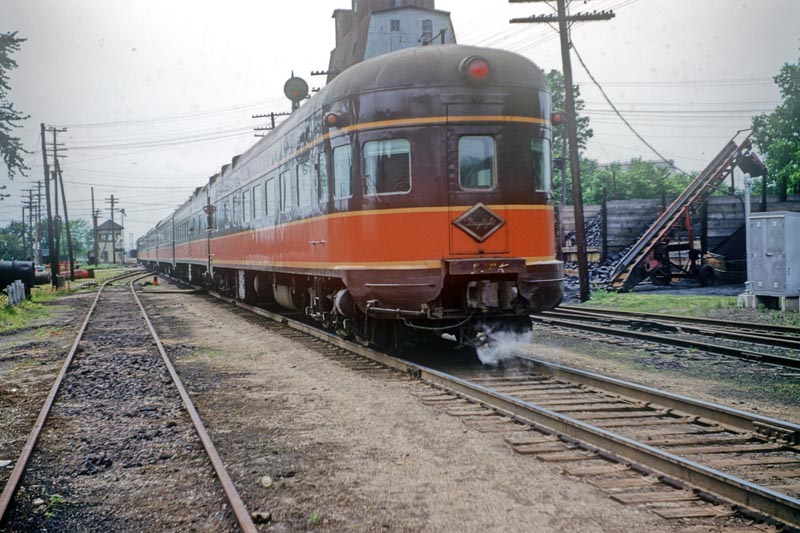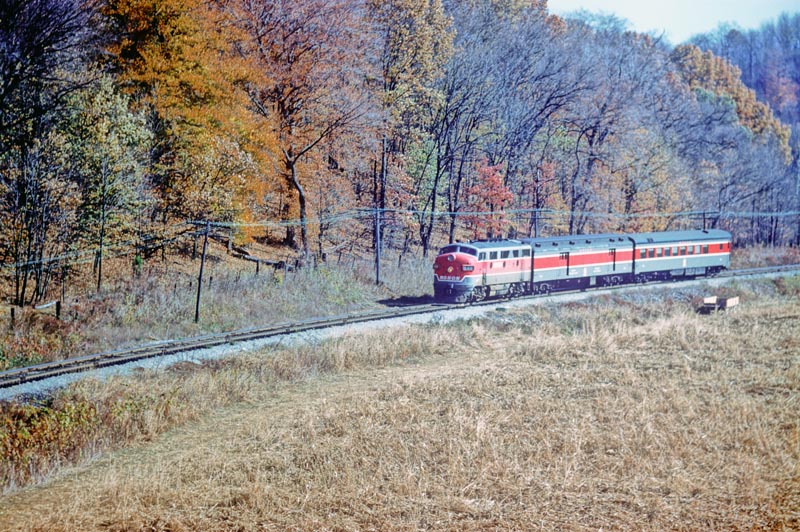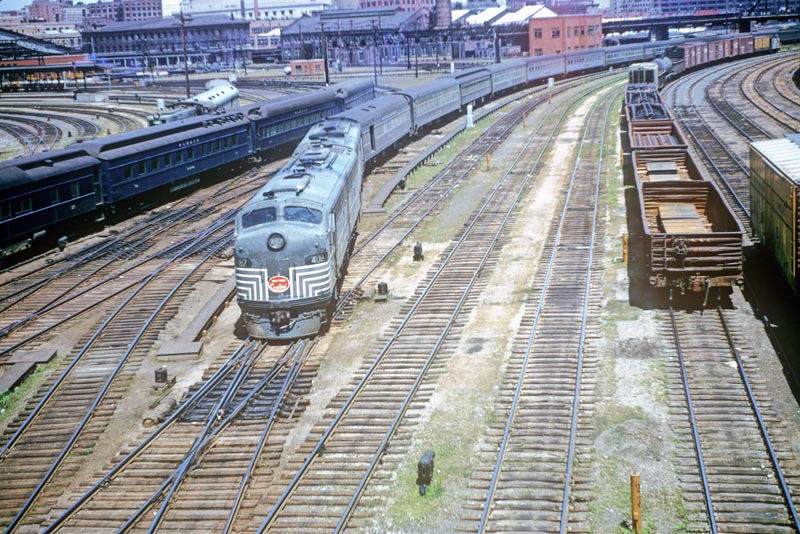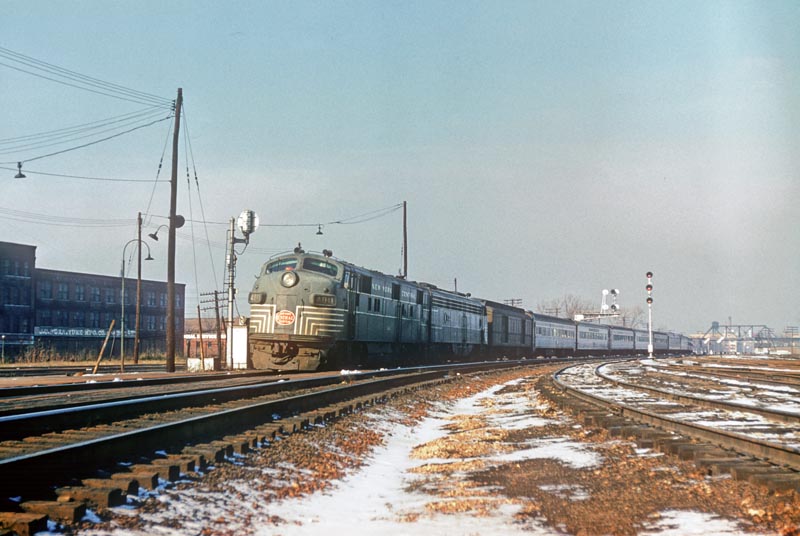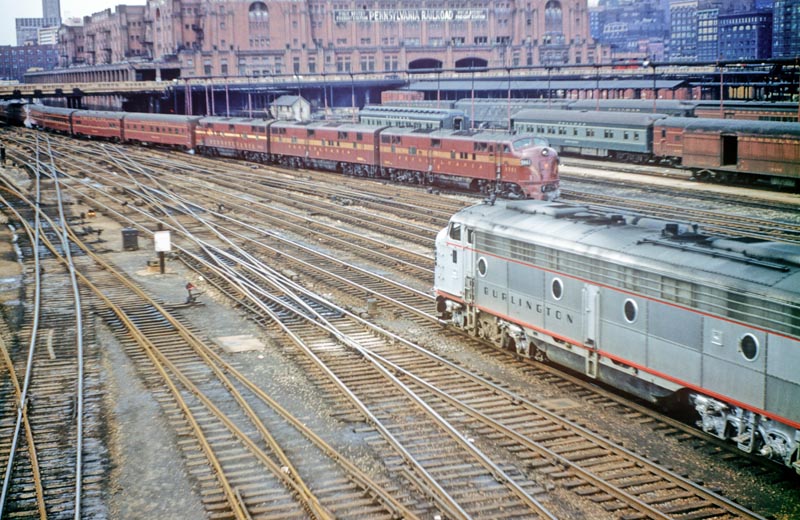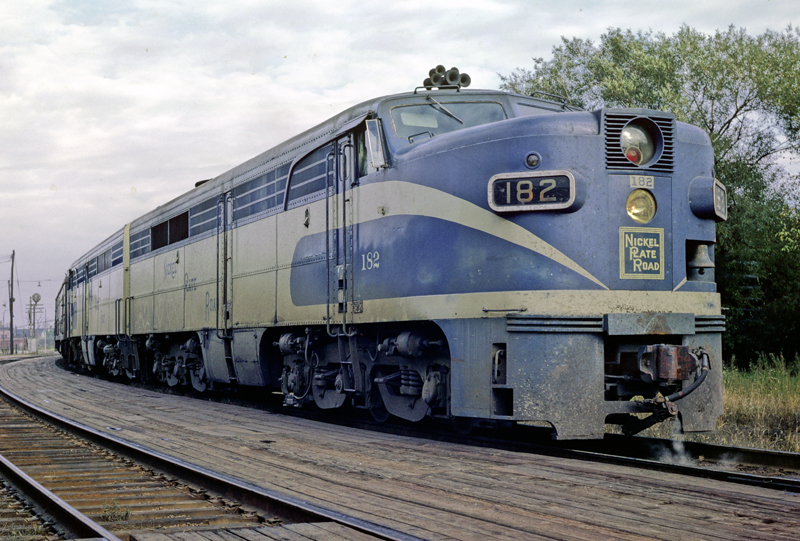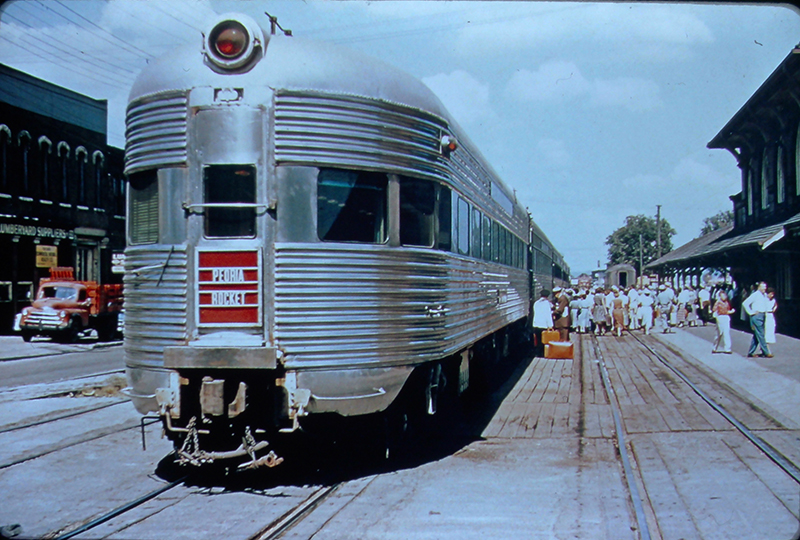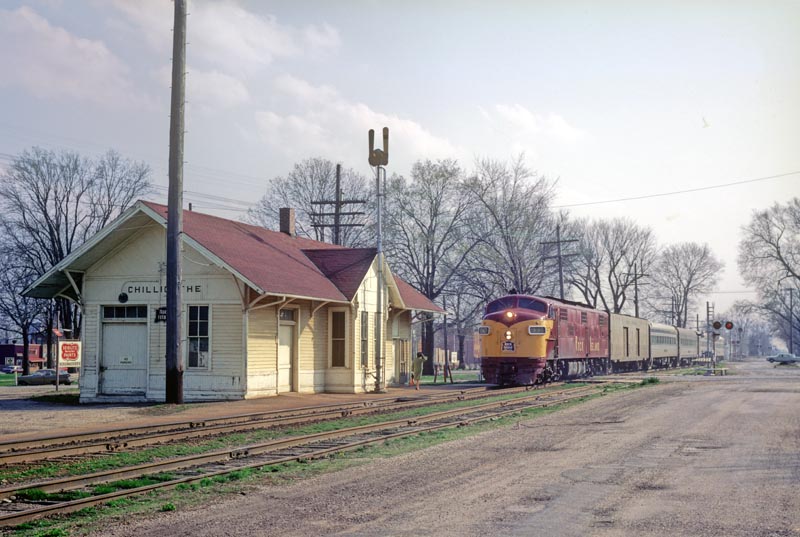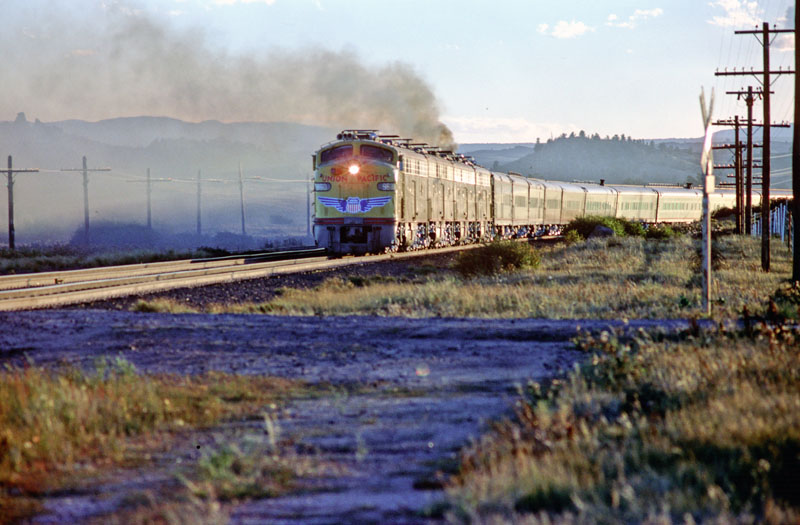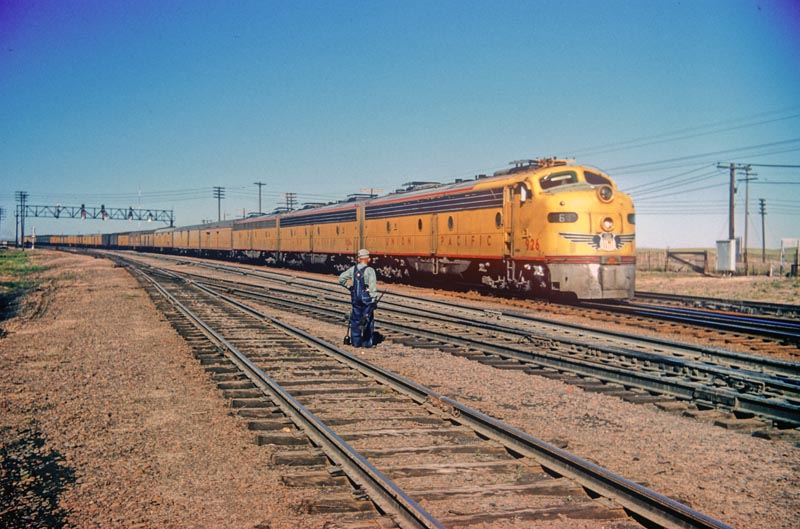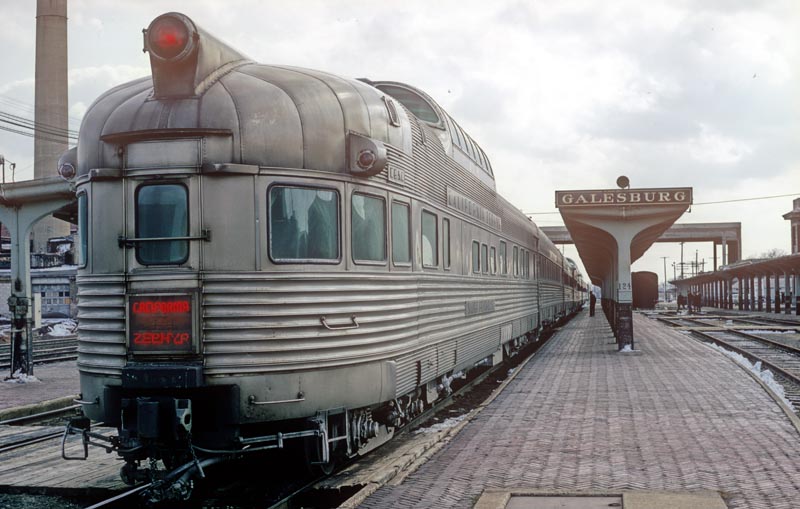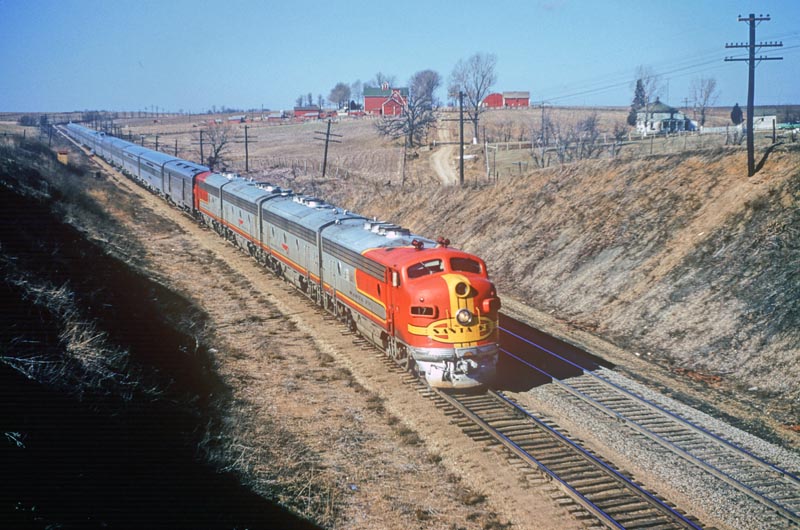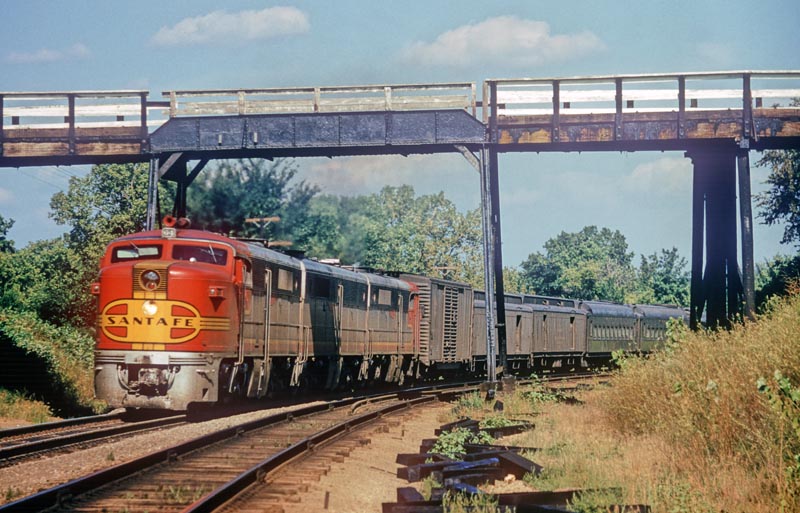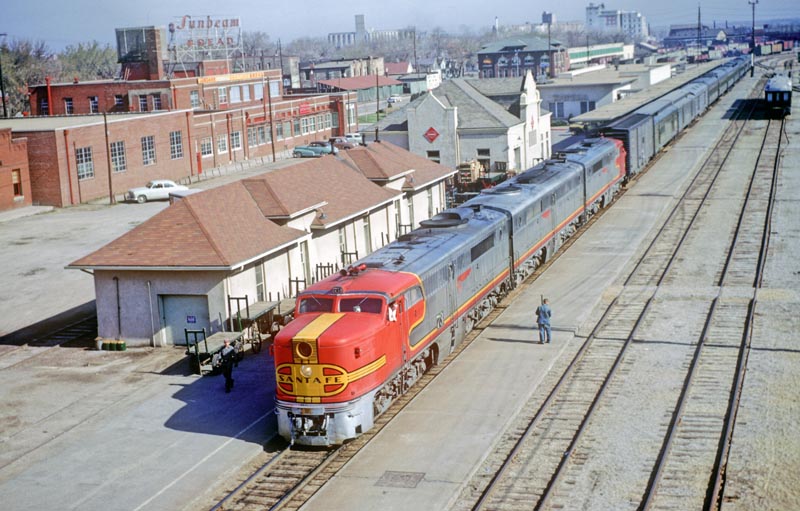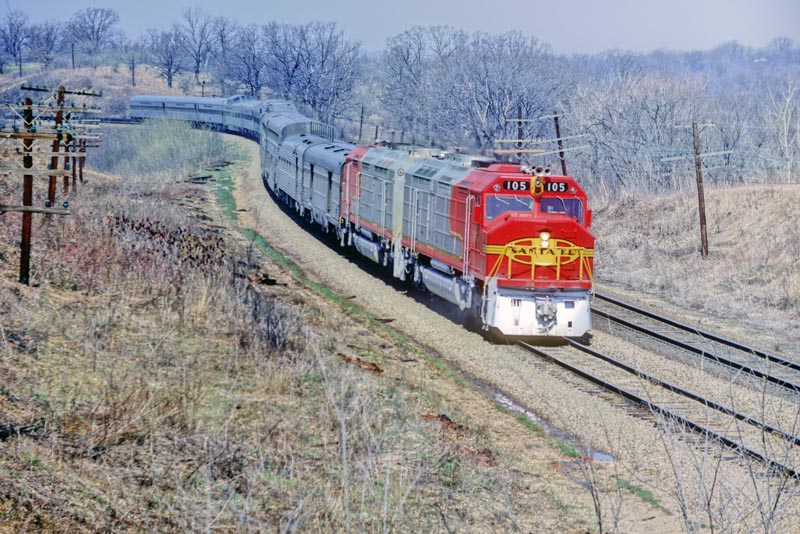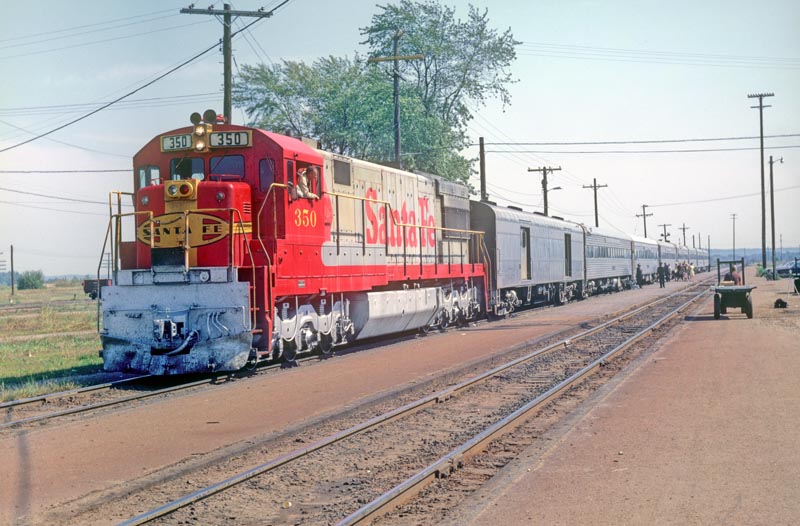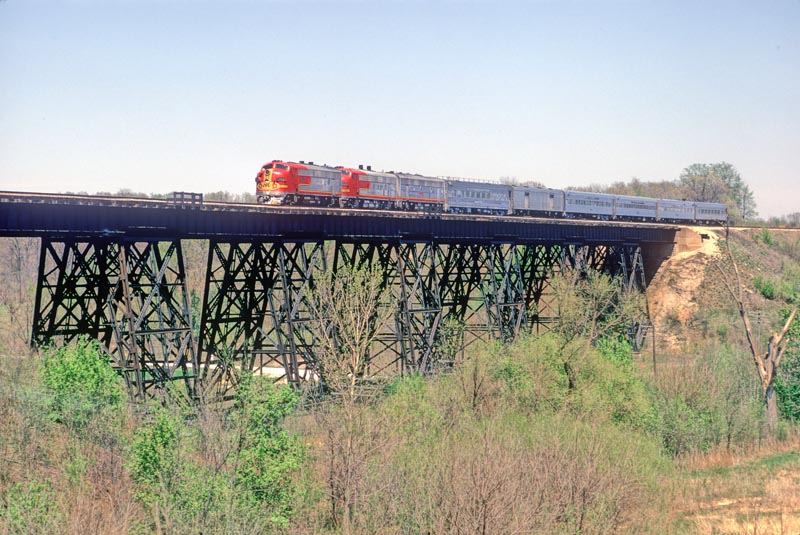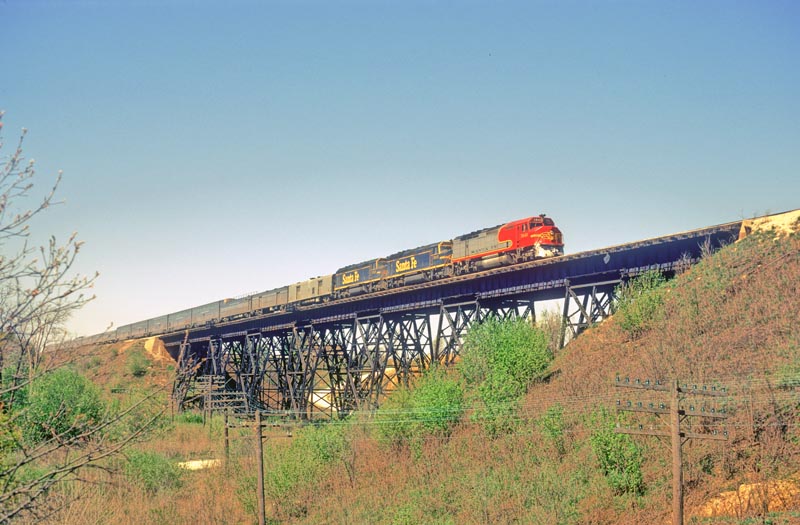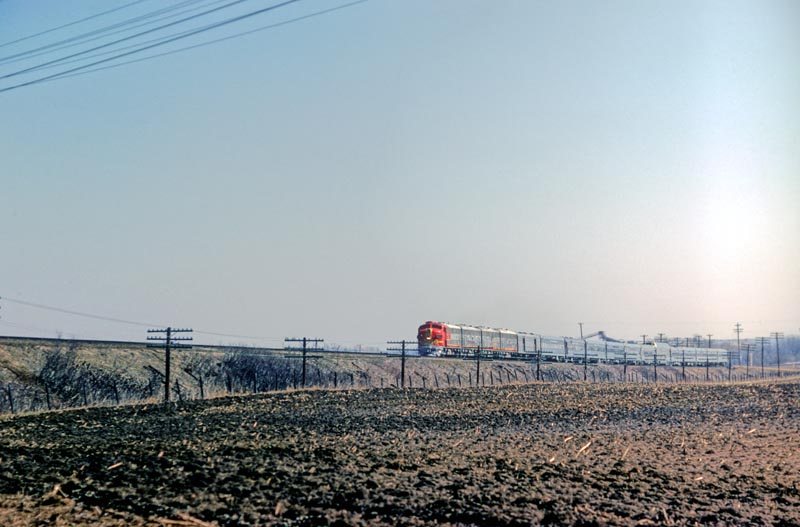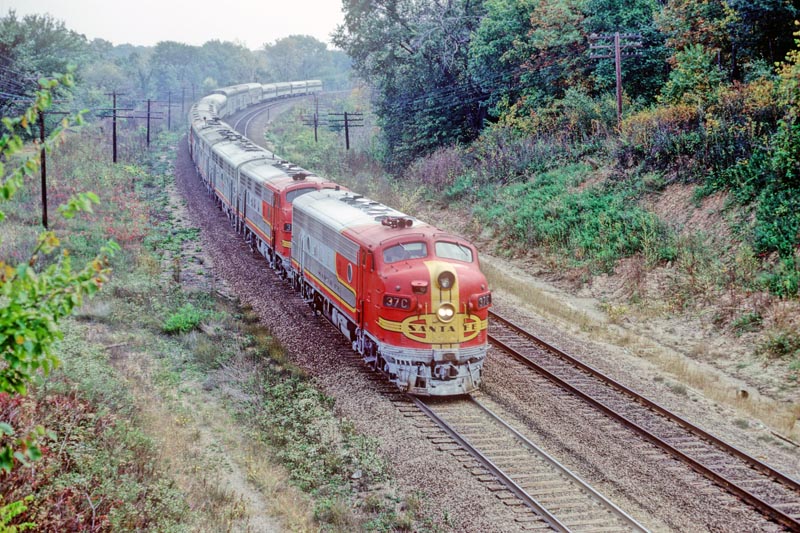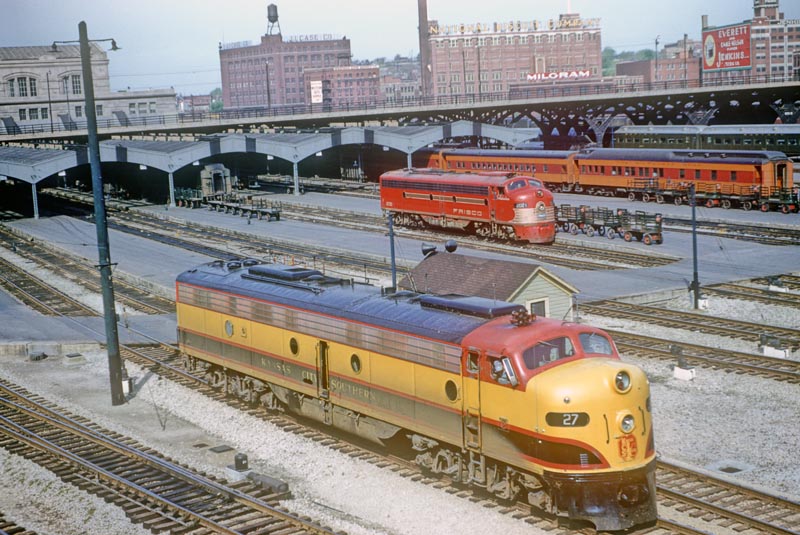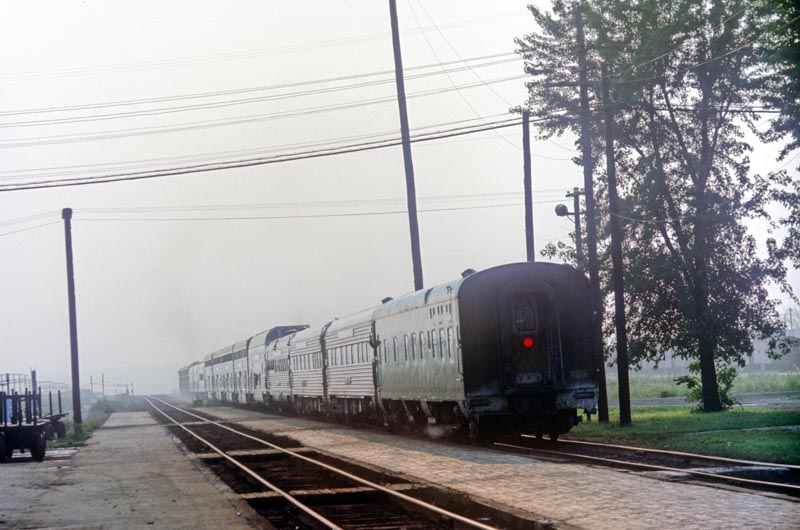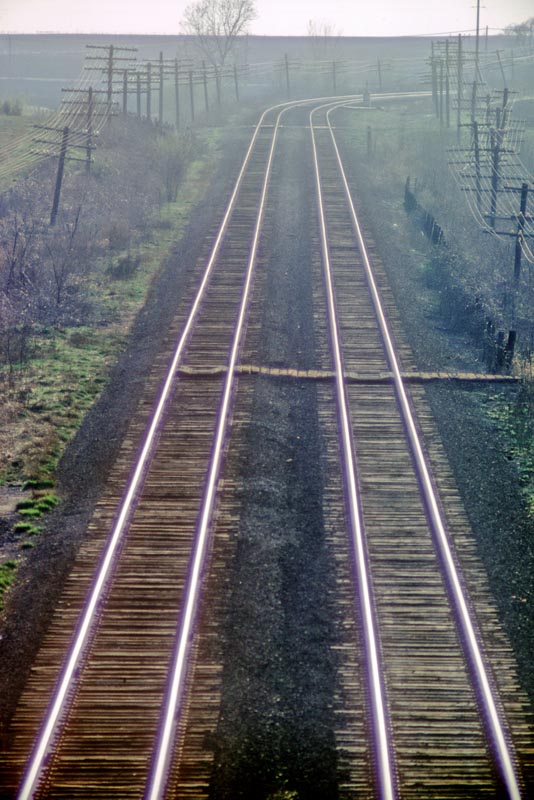Prior to WWII, the steam engine, bellowing its thick dark smoke was king on America’s railroads.
In 1924, however, long before the last steam engine was delivered, a fledgling firm called the Electro-Motive Company was combining a car body from a trolley manufacturer with a six-cylinder 175 HP Winton made gasoline engine to produce a self-propelled rail passenger car.
They were called “doodle bugs.” The new company “EMC” built and sold 400 of these by 1934. In 1930 General Motors boughtboth “EMC” and the Winton Engine Company. It was eventually renamed the Electro Motive Division or “EMD”.
By 1934, “EMD” placed a two-cycle eight-cylinder diesel engine inside a newly designed car body and the first diesel powered stream liner, the Pioneer Zephyr was born.
In November of 1939 “EMD” unveiled a new 1350 HP engine called the “FT” Some units were designed with cabs like the lead unit pictured here called “A” units. Others were designed without cabs. They would be linked to and follow “A” units. They were called “B” units. 
All units were connected electrically, unlike steam engines all of the “A” and “B” units operating as one locomotive.
The “FT” diesel freight engines and “E” diesel passenger engines, seen here on the Burlington Route, were ready to displace steam engines on America’s railroads.
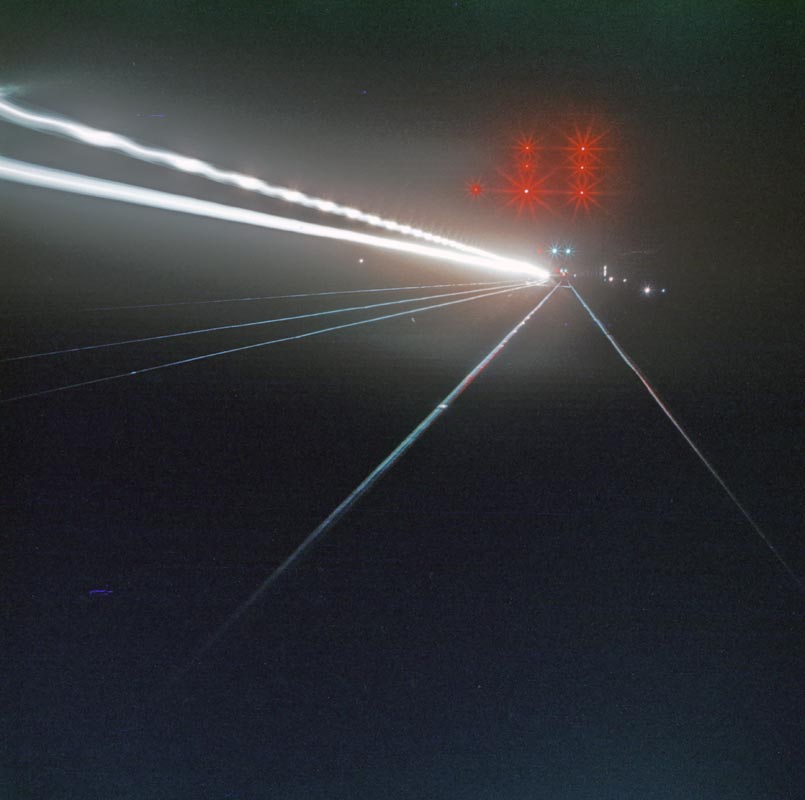
WWII, however, intervened, so it was not until the late 1940s that there was enough production of diesel engines to surpass the steam engine in ruling the rails. The Age of the Streamliner was born.
Dick Neumiller’s interest in photographing railroads started as a result of the streamliner. What a combination of color and power! As a youngster, his dad used to take him north of Peoria to Edelstein, Illinois. A number of years later, he returned to this strip of Santa Fe mainline and aimed his camera down the tracks.
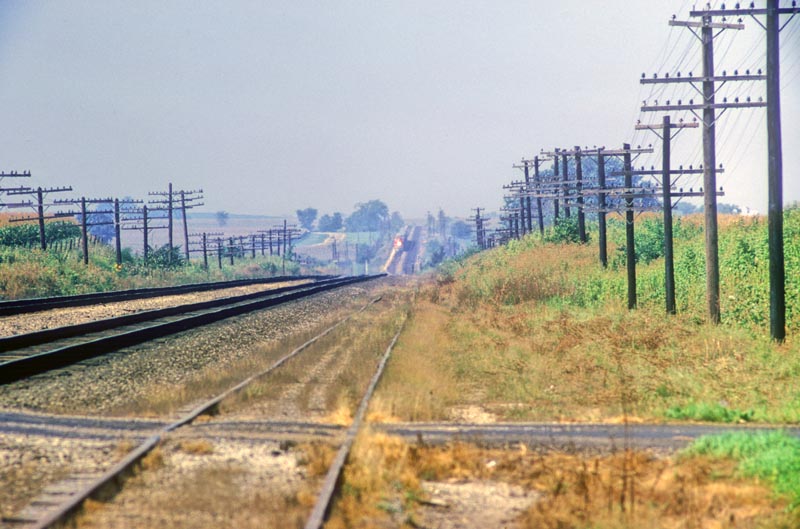
And here it comes.
That shimmering headlight gets larger and larger.
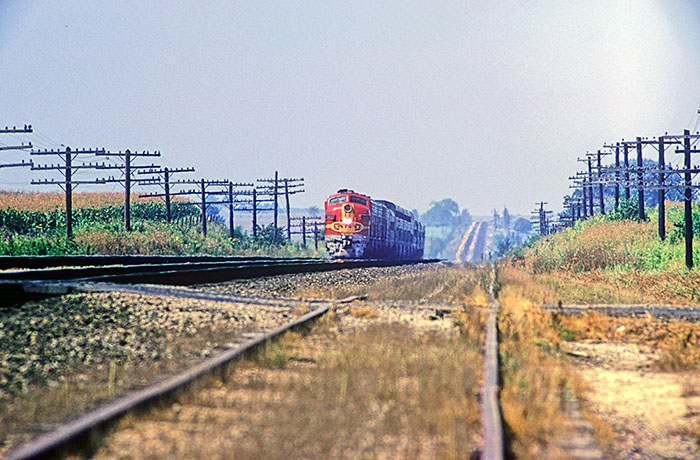
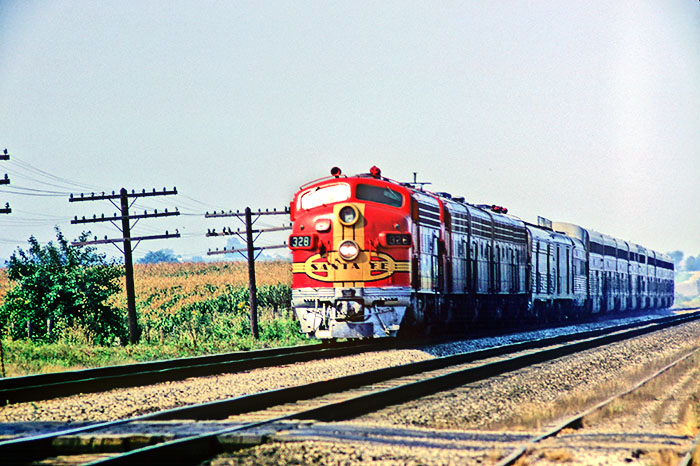
The red and yellow war bonnet design of Santa Fe passenger engines becomes clearer as one of America’s premier streamliners rumbles closer.
It’s the El Capitan -- Santa Fe’s all coach streamliner between Chicago, Illinois and Los Angeles, California with its high-level cars.
Join us as we revisit the Age of the Streamliners.
The Kansas City Southern railroad’s Southern Belle streamliner photographed on November 3, 1957 is leaving New Orleans Louisiana for an overnight run to Kansas City, Missouri. Notice the vivid colors of the diesel engines and cars designed to match.
The Milwaukee Road’s Olympian Hiawatha seen here at Tomah, Wisconsin is Dick’s definition of a streamliner -- colorful diesel engines with cars to match and with
a rounded or specially designed observation car at the end of the train cars. This is the unique Skydome observation car for the Olympian Hiawatha.
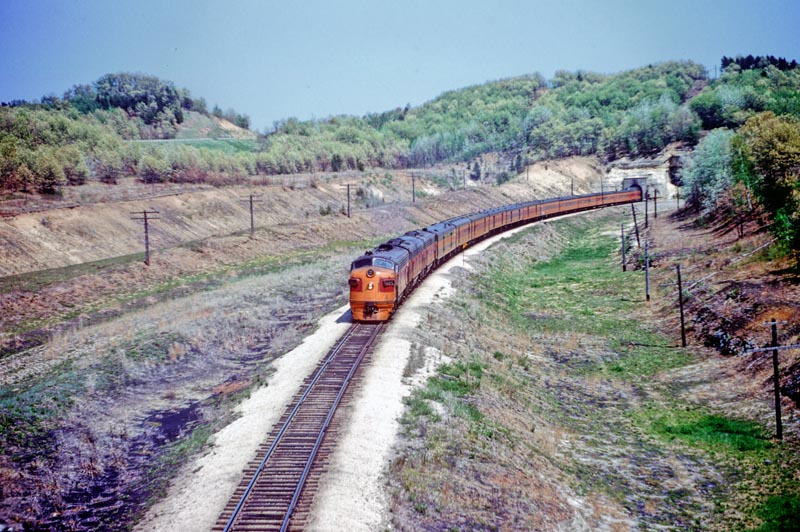
Here is another Milwaukee Road streamliner, the Morning Hiawatha at Tunnel City, Wisconsin. The Milwaukee Road called their streamliners Hiawatha. Chicago Rock Island and Pasific -- Rockets. Missouri Pacific -- Eagles. Union Pacific -- the Cities
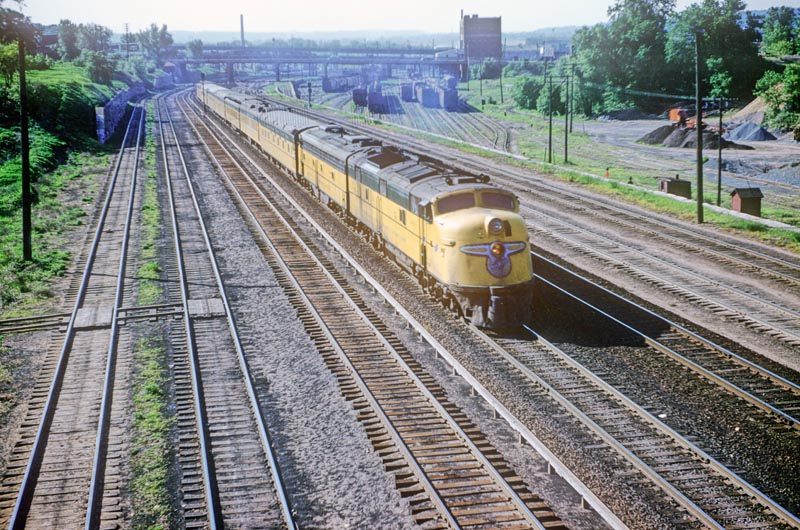
and the Chicago North Western -- the 400s. This is a photo of the Twin Cities 400 arriving in the Twin Cities of Minneapolis, St. Paul, Minnesota. This train traveled 400 miles from Chicago Illinois in 400 minutes. Note the yellow and green color scheme.
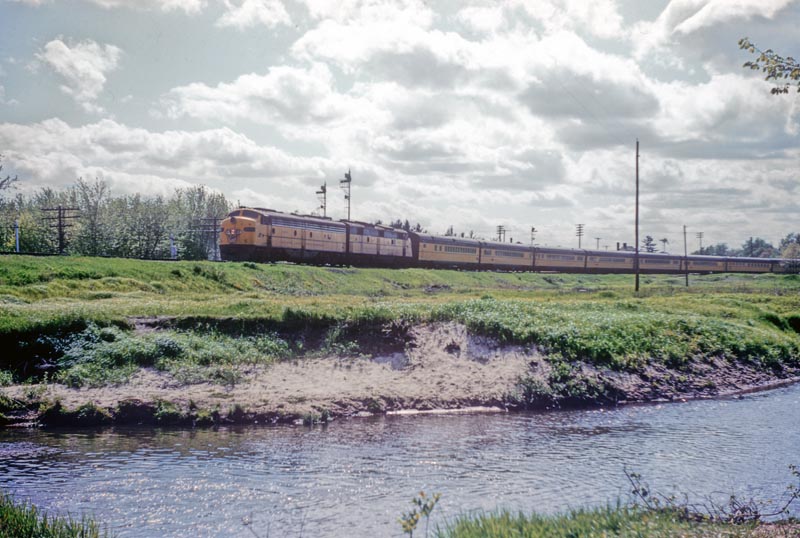
The Chicago bound Twin Cities 400 stops at Wyeville, Wisconsin,
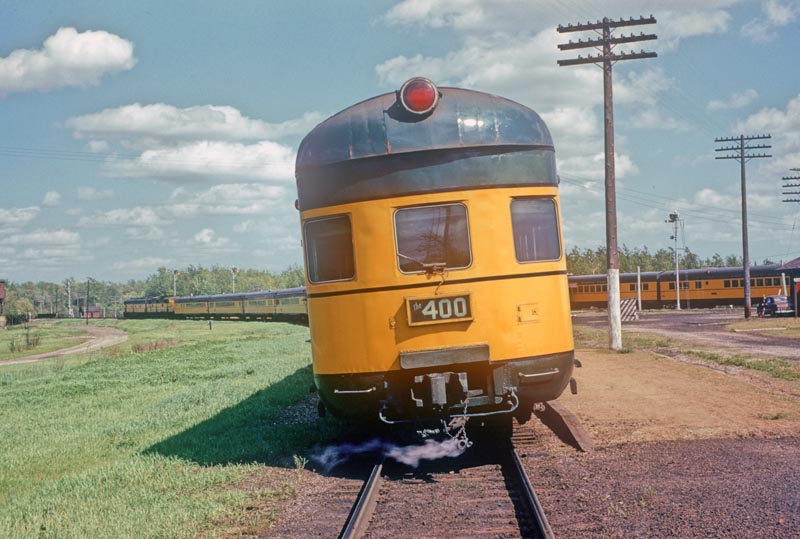
with its distinctive observation car.
Note the cars on the right.
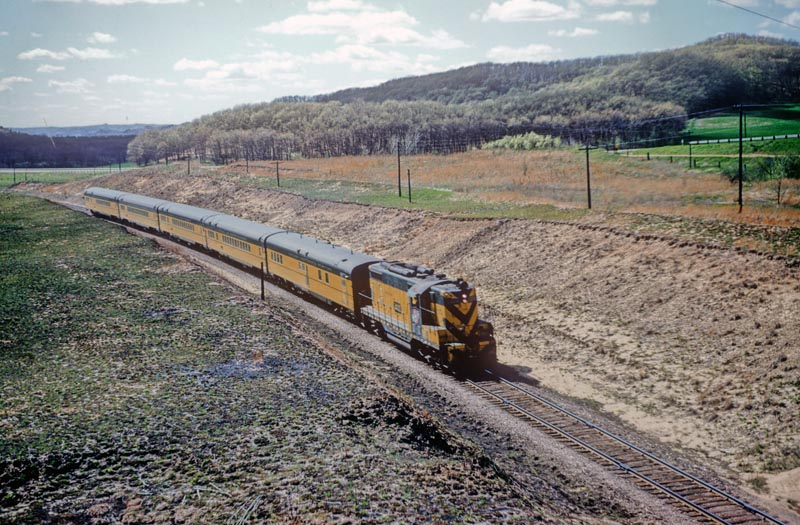 They belong to the Dakota 400 pictured near Tunnel City, Wisconsin. The two trains meet at Wyeville to exchange passengers. One train goes to Chicago through Milwaukee -- the other to Chicago through Madison. But wait, that engine doesn’t look like the others.
They belong to the Dakota 400 pictured near Tunnel City, Wisconsin. The two trains meet at Wyeville to exchange passengers. One train goes to Chicago through Milwaukee -- the other to Chicago through Madison. But wait, that engine doesn’t look like the others.
This is an EMD model GP7. GP is for general purpose. These engines could be used for either passenger or freight work. A tank next to the fuel tank carried water for the steam generator, located in the short hood, that heated the passenger cars. We’ll see a little later how some railroads used these engines to try to rescue their passenger trains to reduce costs.
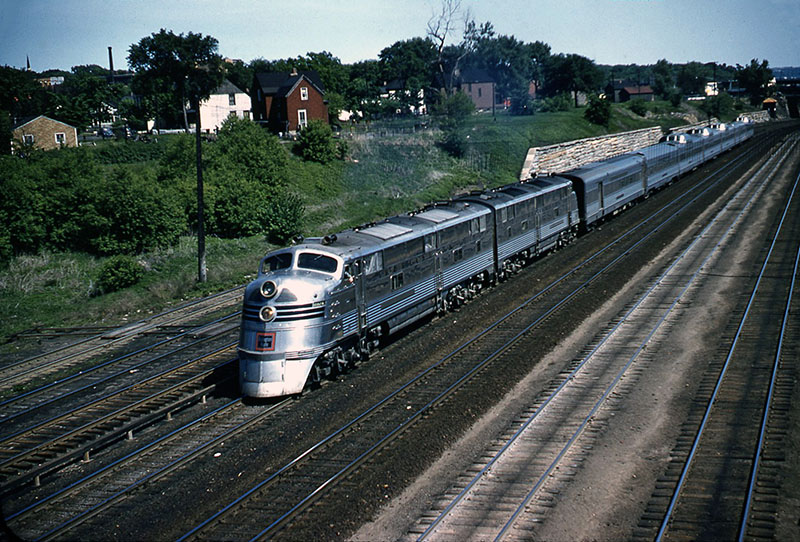
Another great streamliner that ran between Chicago and the Twin Cities was The Twin Cities Zephyr on the Burlington. It was also the first streamliner to use dome cars. These engines are covered with stainless steel. You can see one of these engines working at the railroad museum in Union, Illinois.
No streamliner was more colorful and symbolic than Great Northern’s Empire Builder which ran from Seattle to Chicago via St. Paul, Minnesota
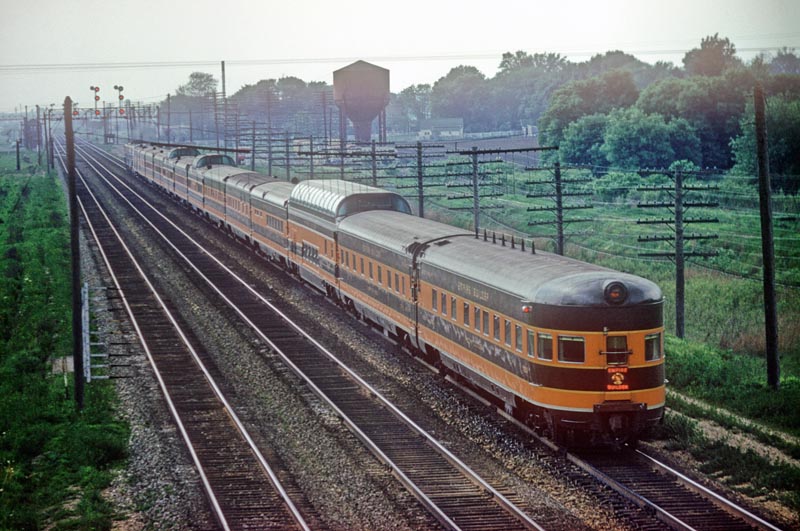
Later the Empire Builder, pictured here at Eola Illinois, added dome cars. Notice the observation car on this train.
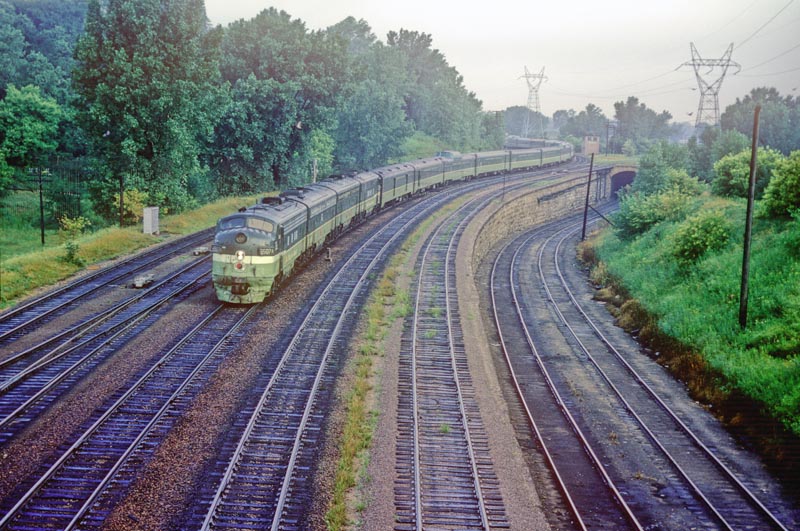
The Northern Pacific’s North Coast Limited is another Seattle to Chicago streamliner.
Not all diesel powered passenger trains were necessarily classified as streamliners. Chicago Great Western’s Mills City Limited from Kansas City to the Twin Cities is seen here with 3 baggage / mail cars and one coach, but the colors do match.
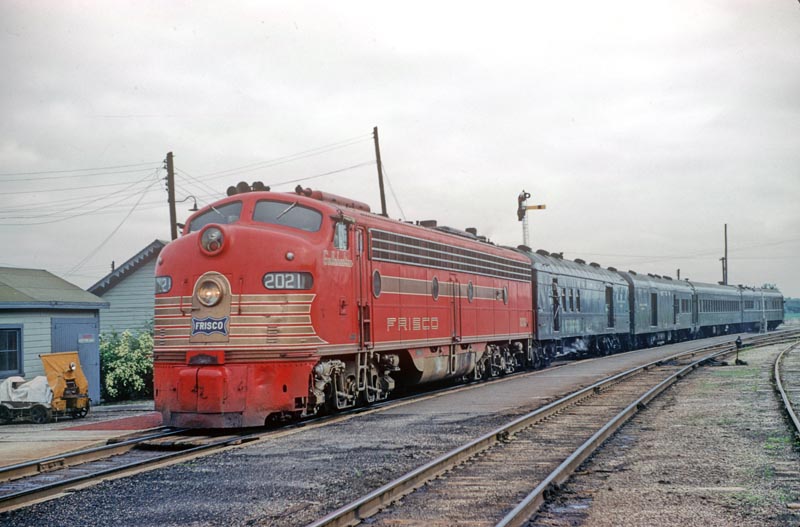
The St. Louis, San Francisco Railroad, or Frisco also had streamliners. The Meteor a St. Louis to Oklahoma City train is seen here at Tower Grove, Missouri.
The engine in this photo looks like a streamliner but not the cars. These coaches were used with steam engines originally, and with many miles left in them, they were used with diesels to pull some secondary passenger trains like FRISCO’s Firefly at Paola, Kansas on 5-2-54.
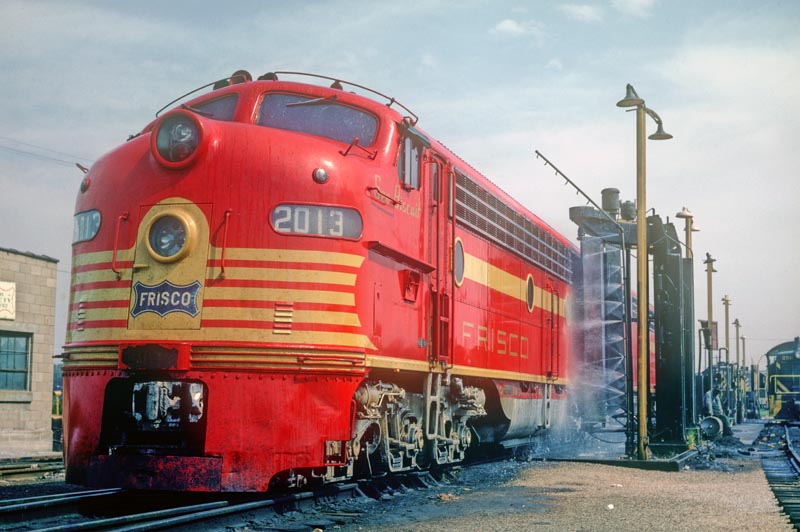
By the way, FRISCO engines were named for famous racehorses. Looks like Sea Biscuit is getting a bath.
The Missouri Pacific called their streamliners -- the Eagles. Look at the big silver eagle on the front of the Missouri River Eagle at Independence, Kansas.
And the Eagle repeats on the observation car.
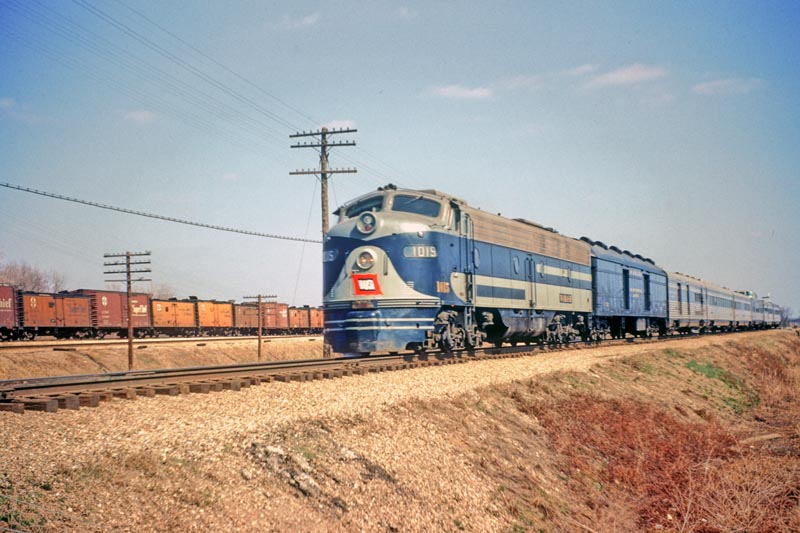
The City of Kansas City, a St. Louis to Kansas City train on the Wabash Railroad was the only streamliner run entirely in the state of Missouri seen here at Carrolton, Missouri February 25, 1954.
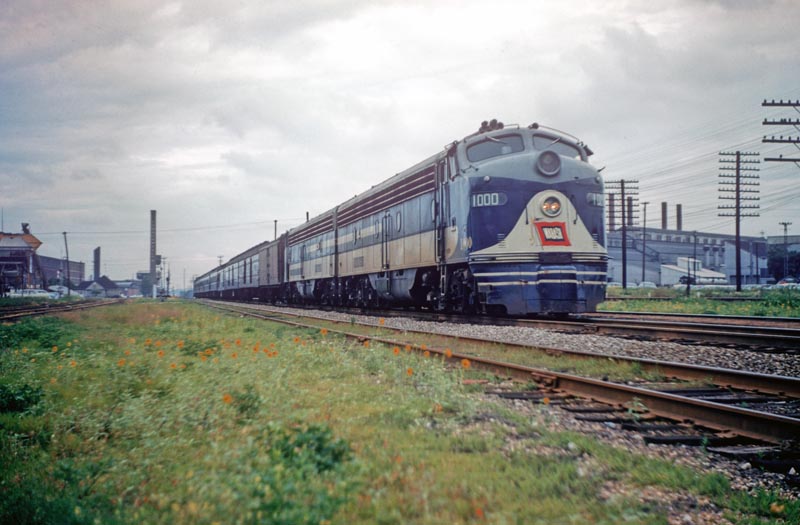
Yes, there really was a Wabash Cannonball pictured here at Granite City, Illinois -- just out of St. Louis on its journey to Detroit.
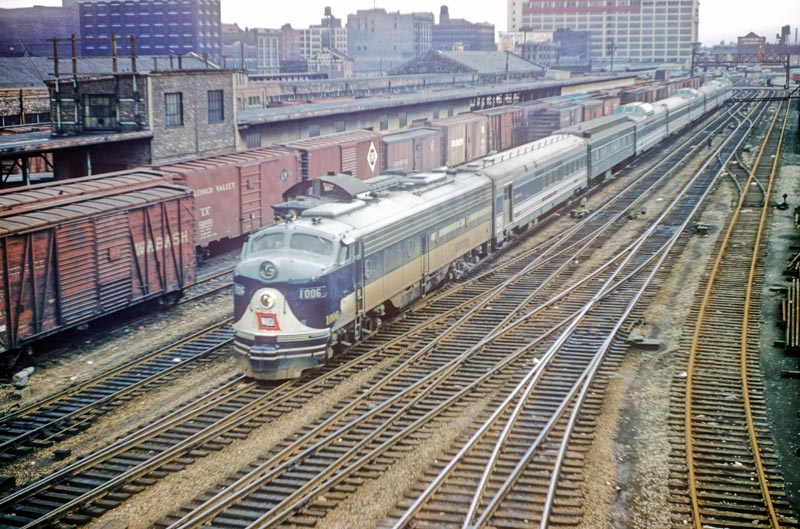
And the Wabash Blue Bird was competing for rail traffic between Chicago and St. Louis it also used dome cars.
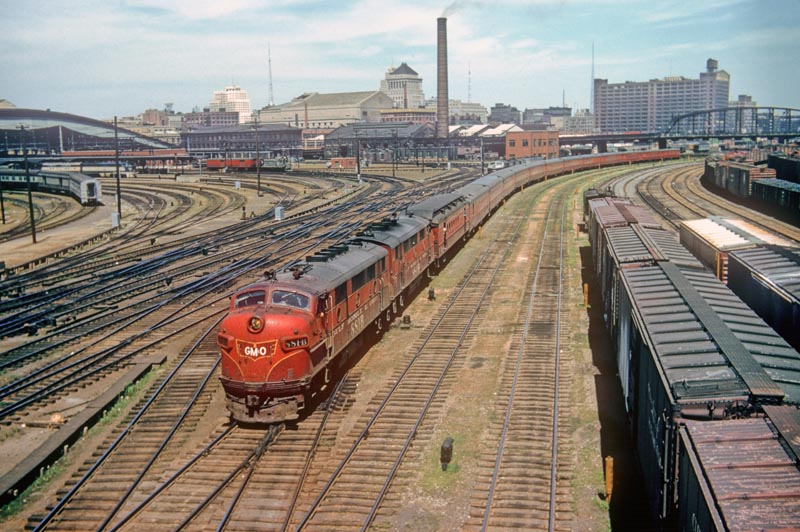
Another railroad in the competition for St. Louis to Chicago passenger traffic was the Gulf Mobil and Ohio with the Ann Rutledge pictured here in St. Louis June 23, 1957. Note St. Louis railroad station in the background.
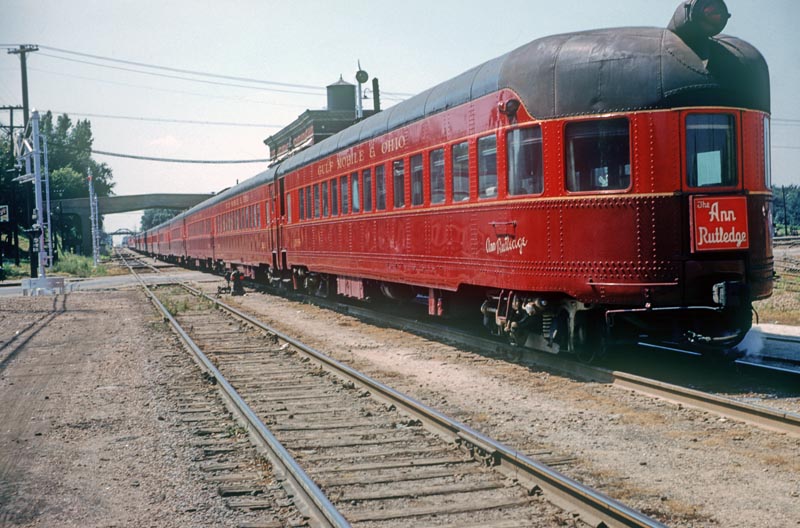
Later we see the Ann Rutledge observation car at Bloomington Illinois and then.
Illinois Central’s Green Diamond is leaving St. Louis for Chicago. The third railroad competing for traffic between Chicago and St. Louis with one of the oldest streamliners which started service March 27, 1936.
Here is the Illinois Central Daylight at Gibson City, Illinois May 11, 1955.
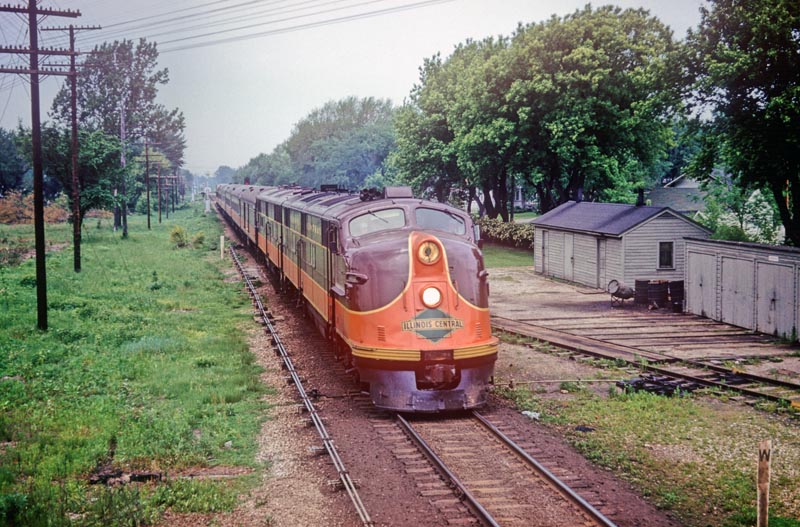
And this is Illinois Central, Chicago to Sioux City, Iowa train known as the Land of Corn.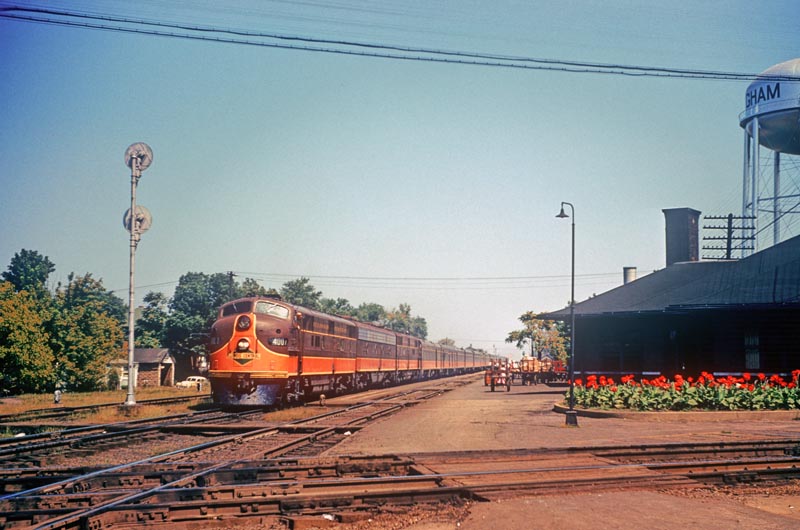
Another one of Illinois Central’s superb passenger trains was the all coach City of New Orleans passing through Effingham, Illinois August, 25 1955.
Perhaps one of the best-loved streamliners was the Panama Limited approaching New Orleans on November 6, 1957 on its way from Chicago.
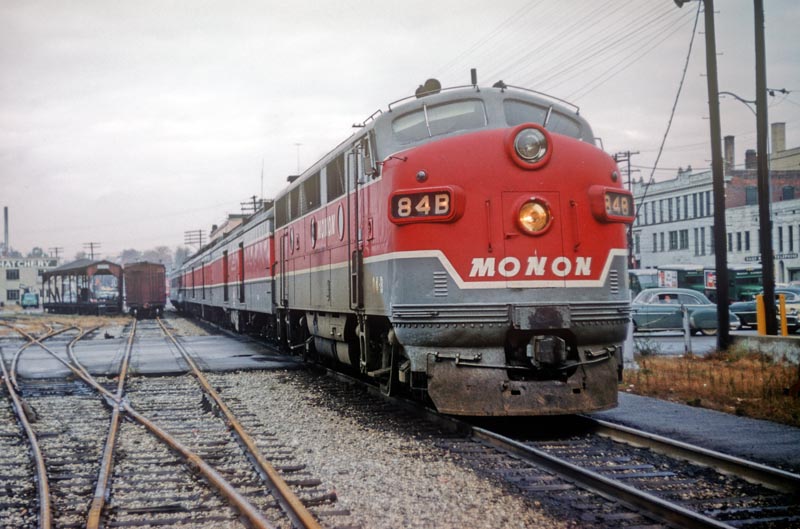
Officially it was The Chicago, Indianapolis and Louisville railroad, but everyone called it the Monon. Red and gray were its colors. This train from Chicago to Louisville is the Thoroughbred.
Shortly before service was ended, we see the North bound Thoroughbred near Harrodsburg, Indiana with one engine, one baggage car and one coach.
The New York Central’s Knickerbocker traveled from St. Louis to New York City. Here we see it coming into St. Louis.
This is the New York Central’s 5th Avenue and Cleveland Limited at Englewood, Ill.
A competitor of the New York Central was the Pennsylvania Railroad it’s Liberty Limited is seen leaving Chicago Illinois.
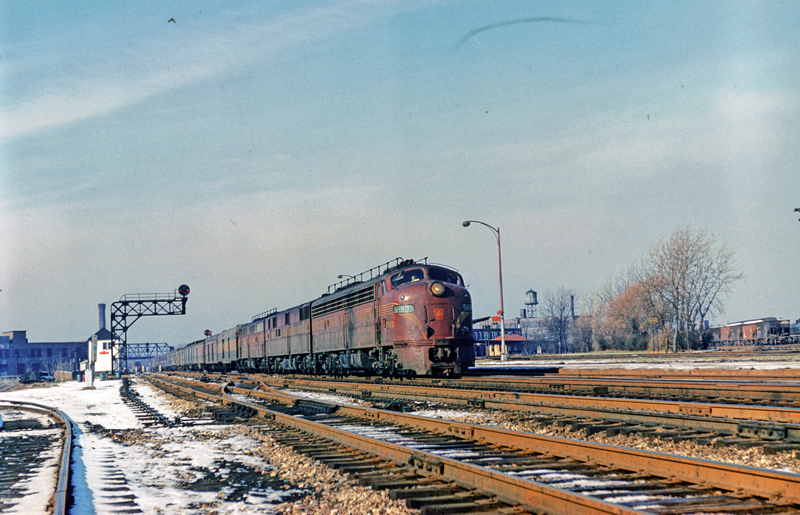
Another Pennsylvania Railroad streamliner, the Manhattan Limited photographed at Englewood Ill.

Here the Spirit of St. Louis backing into St. Louis station to the right is the MISSOURI Pacific’s Colorado Eagle. Perhaps you can tell these engines are not the same. Pennsylvania is an “EMD” “E8”. MISSOURI PACIFIC is an ALCO manufactured by the American Locomotive Company in Pennsylvania.
Let’s take a closer look at an ALCO “PA”. The Nickel Plate Railroad, really the New York to Chicago and St. Louis Railroad used ALCO “PA’s” on trains from Chicago to Cleveland.
This train was just simply called No. 8. Some railroads didn’t really refer to their trains by name like the Abe Lincoln, or Broadway Limited, or the Green Diamond, they referred to them by their number.
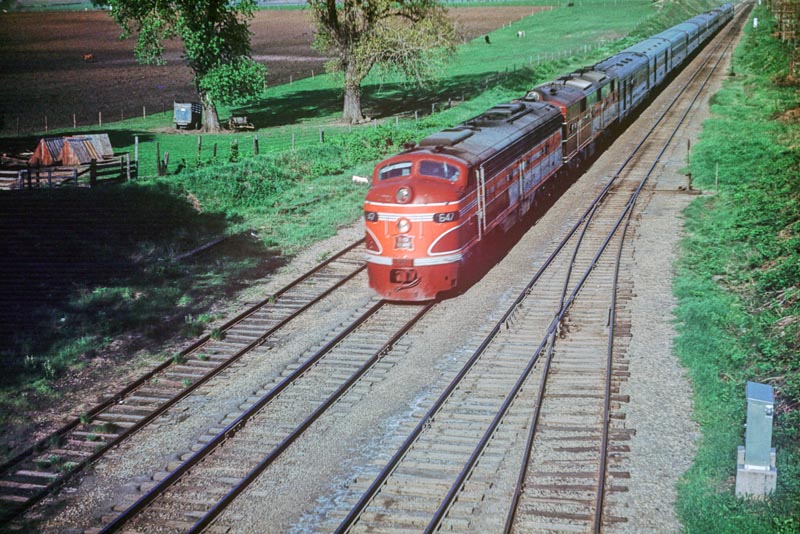
Rock Island’s Rocky Mountain Rockets were trains No. 7 and No. 8. A train traveling westbound or southbound had odd numbers and those going east or north was given even numbers. The Rocky Mountain Rocket here is No. 7 westbound at Sheffield, Illinois.
The Texas Rocket at Herrington, Kansas was No. 18 going northbound to Minneapolis - St. Paul from Dallas - Fort Worth.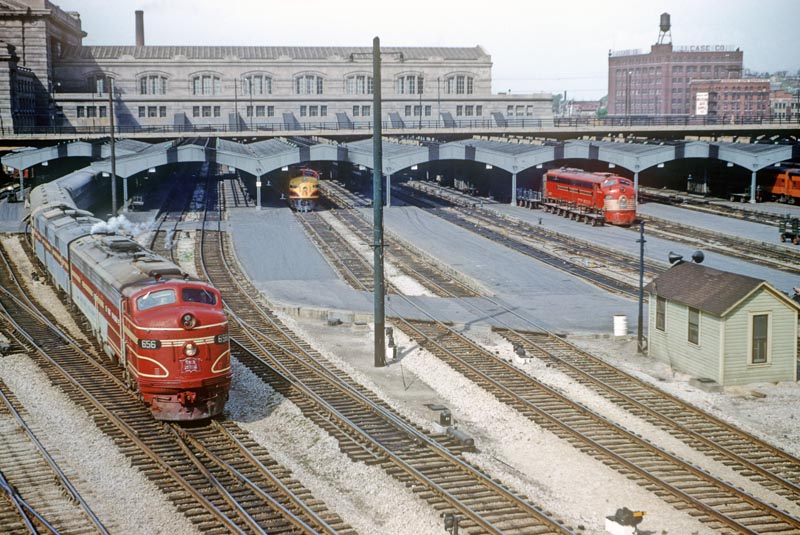
At Kansas City, Missouri Union Station, we see the Rock Island Twin Star Rocket No. 508 just leaving for Minneapolis - St. Paul on its way from Houston, Texas.
This is the Peoria Rocket at Peoria Illinois,
and on April 7, 1968 the Peoria Rocket is stopping at Chillicothe Illinois.
Here is a rare treat, four “E9” passenger units in an “A-B-B-A” arrangement pulling one of “UP’s” famous Cities streamliners.
Train No. 104 The City of Los Angeles Eastbound at Dale, Wyoming.
Here is train No. 6 with Engine 926. Three E units “A-B-B” photographed in July 1958 was an all-mail, eastbound train with only 2 coaches. When passengers headed to the interstates and airlines, railroads used their mail business to hold some trains on line. When they lost mail contracts, they lost them all.
The California Zephyr at Galesburg Illinois is on its way from Chicago Illinois to Oakland California.
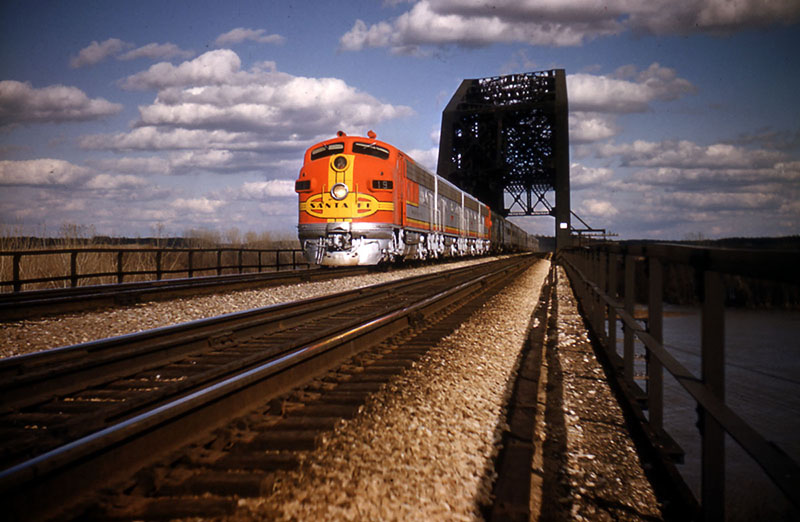
Santa Fe Chief No. 19 is westbound. This Extra fare Chicago to Los Angeles train made the trip in 39 1/2 hours. That’s almost a mile a minute.
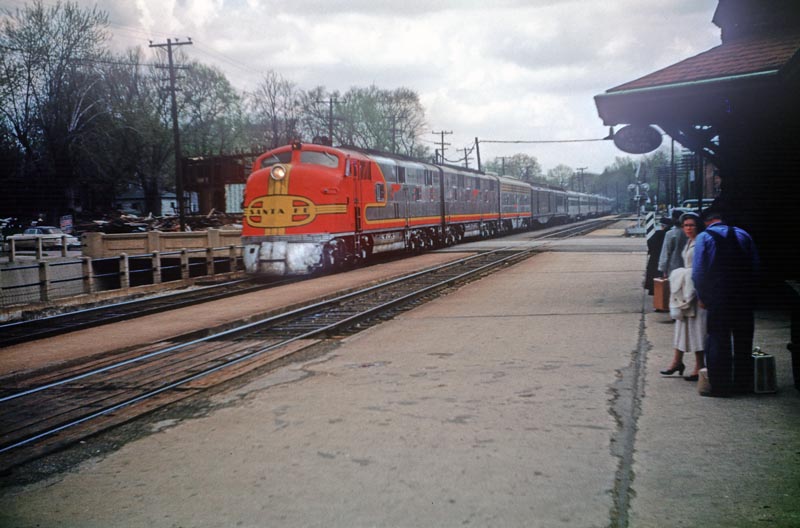
Santa Fe’s Kansas Citian, their Chicago to Kansas City train made round trips between these two mid-western cities. This photo was taken in Galesburg, Illinois.
Here the eastbound Super Chief train No.18 descends Edelstein Hill. The engines on this train are war bonnet “F7”s in an A-B-B-A configuration.
Wow! Three ALCO PA’s on the Santa Fe Grand Canyon in A-B-A configuration. No green flags, this train sometimes ran with a second section.
Later we see the see the ALCOs waiting to depart.
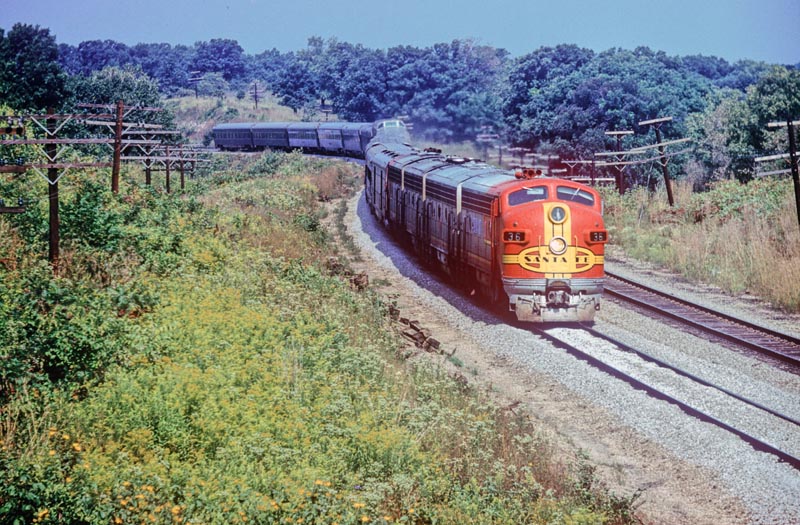
The San Francisco Chief pictured here on the S curve is descending Edelstein Hill just west of Chillicothe, Illinois.
Eleven years later in 1968 we see the same train at the same location. What a difference. The engines are brand new “EMD FP 45”s.
Remember the Chicago North Western Dakota 400 with a “GP7”, the engine that could be used to freight or passenger. Well here we see the newer “GE” “U28CG” made by General Electric for passenger or freight trains on the Westbound Santa Fe Grand Canyon at Chillicothe Illinois.
This is the same train, The Grand Canyon at Media, Illinois westbound April 24,1971with EMD F7s in an “A-A-B” configuration.
The eastbound Super Chief - El Cap. Were run combined behind two freight engines and one passenger engine. The Santa Fe’s passenger engines were repainted to their blue and yellow freight colors only to be repainted to the famous War bonnet paint scheme as a marketing tool for fast freight.
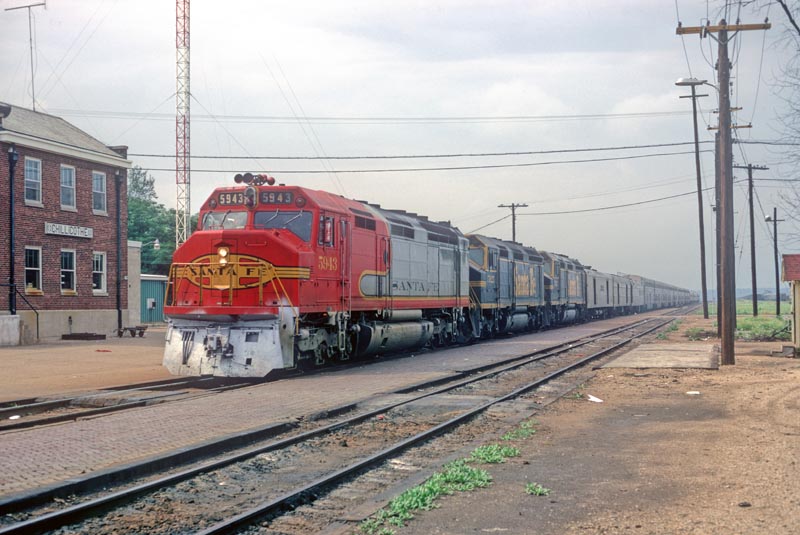
Here is a closer look at the same train in Chillicothe Illinois.
Oh to be able to return to the Era of the Streamliners!
Westbound No. 19
The Santa Fe Chief is beginning its climb out of Illinois River Valley,
and pulling up Edelstein Hill.
To return to those colorful days of the E8s in their different paint schemes.
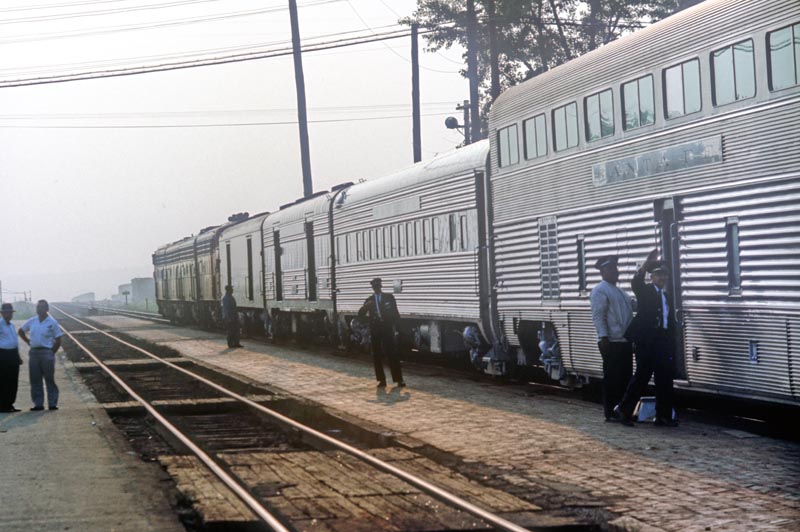
The conductor with his hand up telling us its time to get on board.
……….…All Board!..........
As we bid farewell to the Age of the Streamliners, we want to thank all of you for joining us to relive those wonderful days. So long for now.
Happy Railroading
Additional Photographs by C. Richard Neumiller
The Milwaukee Road
Early WSOR
Alcos by C. Richard Neumiller
Join us in the “Greatest Hobby” as a member of the TLMRC.
Update 5/19/2025

